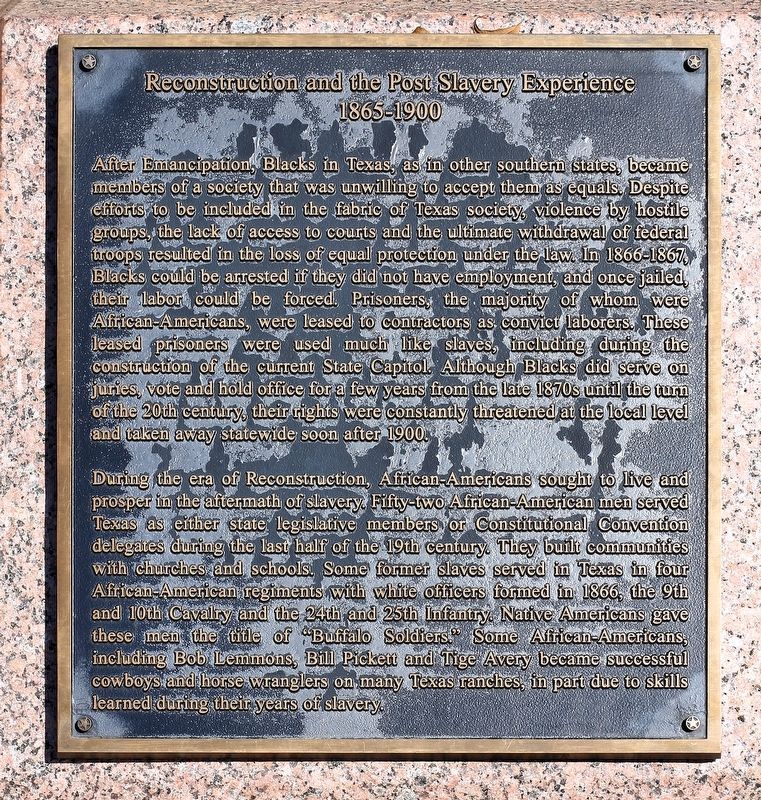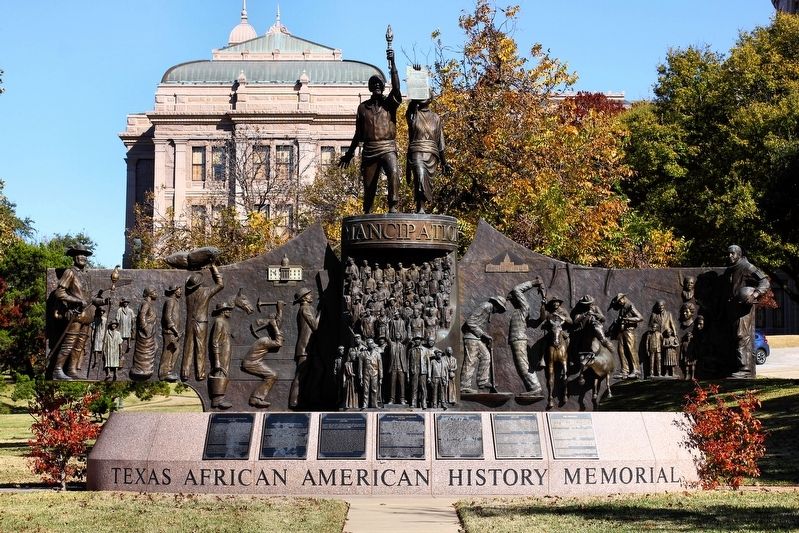Downtown Austin in Travis County, Texas — The American South (West South Central)
Reconstruction and the Post Slavery Experience
1865-1900
Inscription.
After Emancipation Blacks in Texas, as in other southern states, became members of a society that was unwilling to accept them as equals. Despite efforts to be included in the fabric of Texas society, violence by hostile groups, the lack of access to courts and the ultimate withdrawal of federal troops resulted in the loss of equal protection under the law. In 1866-1867, Blacks could be arrested if they did not have employment, and once jailed, their labor could be forced. Prisoners, the majority of whom were African-Americans, were leased to contractors as convict laborers. These leased prisoners were used much like slaves, including during the construction of the current State Capitol. Although Blacks did serve on juries, vote and hold office for a few years from the late 1870s until the turn of the 20th century, their rights were constantly threatened at the local level and taken away statewide soon after 1900.
During the era of Reconstruction, African-Americans sought to live and prosper in the aftermath of slavery. Fifty-two African-American men served Texas as either state legislative members or Constitutional Convention delegates during the last half of the 19th century. They built communities with churches and schools. Some former slaves served in Texas in four African-American regiments with white officers formed in 1866, the 9th and 10th Cavalry and the 24th and 25th Infantry. Native Americans gave these men the title of "Buffalo Soldiers." Some African-Americans, including Bob Lemmons, Bill Pickett and Tige Avery became successful cowboys and horse wranglers on many Texas ranches, in part due to skills learned during their years of slavery.
Erected 2016 by Texas African American History Memorial Foundation.
Topics. This historical marker is listed in this topic list: African Americans. A significant historical year for this entry is 1900.
Location. 30° 16.397′ N, 97° 44.489′ W. Marker is in Austin, Texas, in Travis County. It is in Downtown Austin. Marker is at the intersection of West 11th Street and Congress Avenue, on the right when traveling west on West 11th Street. The marker is on the grounds of the Texas State Capitol. Touch for map. Marker is at or near this postal address: 1100 Congress Avenue, Austin TX 78701, United States of America. Touch for directions.
Other nearby markers. At least 8 other markers are within walking distance of this marker. Civil War, Emancipation and Juneteenth (here, next to this marker); Post Reconstruction Challenges and Achievements (here, next to this marker); Slavery During the Republic and Early Statehood (here, next to this marker); Major Achievements (here, next to this marker); Slavery During the Mexican National Era (here, next to this marker); Hendrick Arnold and Samuel McCulloch, Jr. (here, next to this marker); The 21st Century (here, next to this marker); First Contact and the Spanish Colonial Era (here, next to this marker). Touch for a list and map of all markers in Austin.
More about this marker. The marker is one of ten markers on the Texas African American History Memorial. The monument honors the many contributions of African Americans in Texas. The markers trace the history of African Americans from the 1500s to the present.
Credits. This page was last revised on February 1, 2023. It was originally submitted on December 20, 2020, by Larry D. Moore of Del Valle, Texas. This page has been viewed 262 times since then and 47 times this year. Photos: 1, 2. submitted on December 20, 2020, by Larry D. Moore of Del Valle, Texas.

